Organizations are constantly compressed to yield and change. Firms, along with the changes in the market, have to cope with the altered needs of customers in new ways of negotiating change. Cross-functional collaboration is one of the most important methodologies that can be applied for achieving sustainability in this kind of scenario, apart from furthering improvement in communication. This methodology drives business transformation towards success.
Definition of Cross-Functional Collaboration
Cross-functional collaboration involves an application with individuals from diverse departments or functional areas in working to accomplish something on an organization. This method challenges teams of differing skills, experiences, and skills to work on projects or programs. For instance, a marketing team will combine product development, sales, and customer service in releasing a new product. Hence, diverse functions prompt a comprehensive method to solve issues and innovation.
Benefits of Innovation with Diverse Perspectives
The most appealing aspect of cross-functional collaboration is the rich tapestry of ideas generated from diverse perspectives. Each department has unique insights and experiences that lead to highly innovative solutions when combined together. For example, a finance team’s analytical mind can help interpret market feasibility, while creative thinking by the marketing team can shape meaningful messaging. When diverse viewpoints come together, organizations are more likely to discover innovative strategies in alignment with customer needs.
Diverse teams have also been found to be effective in critical thinking. They tend to see issues from a number of different sides, thus increasing the probability that groupthink—the situation where an agreement is arrived at due to a failure of optimal decision-making—is avoided. In order to ensure an innovative culture, organizations must encourage cross-function collaboration.
Process Streamlining Toward Efficiency
This allows cross-functional teams to increase efficiency in operations levels. Organizational silos become a source of bottleneck and delays. Overlapping efforts from several teams often causes delays hence while collaborating, overlapping is avoided by making fewer processes and other means of efficiency. Availability of goods at the stores often culminates to increased time when there are unmatched demands such as sales that could have met that demand as sold to a customer.
Further improvement on internal workflow organization can be realized by breaking silos. As people develop closer ties to their colleagues, their functions, and issues, a sense of sympathy and teamwork becomes almost intrinsic. It makes problems get solved faster, which means enhanced performance and productivity.
Creating a Customer-Centric Approach
Today’s customer-driven market needs understanding of consumer needs and preferences. Cross-functional collaboration is how organizations can work more customer-centered. Product or services are built with understanding the real demand of the market through discussions on customer feedback from a multiple department involvement in any organization.
For instance, a customer service process that is integrated with new product development using collaboration will actually design features closest to a complaint by a customer. The businesses augment their offering and reinforce the loyalty and satisfaction of customers by bringing customer information into planning.
Designing Agile Response Ability to Change
This means that business environments are in a constant change at breakneck speeds, and only agile organizations will be able to thrive. Cross-functional collaboration readies teams to react to changes in market shifts, changes in regulations, or new technologies. Departments can shift strategies more nimbly and make sure the organization stays relevant and competitive.
For example, in a crisis or an unexpected challenge, a collaborative team can share resources and knowledge to develop solutions rapidly. Such agility will allow organizations to remain resilient when uncertainty occurs and ensure a smooth transition when changes are needed.
Promote a Learning Culture
Cross-functional collaboration also promotes the culture of continuous learning. Individuals from different disciplines can share knowledge and skills, which are critical for professional development. For instance, a software developer working with a marketing team may learn how to engage the user effectively. On the other hand, marketers may learn about technological capabilities, which will enable them to craft better campaigns.
This learning culture not only brings out the maximum potential in individuals but also enhances the overall skill development of the company. As these employees become multilateral, they may be able to contribute more appropriately to different types of projects to make the force more knowledgeable and adaptable.
Cross Functional Collaborations Role of the Leadership
The leadership aspect needs to be nurtured for developing cross-functional collaboration. Leaders should establish an environment which encourages open communication and mutual respect among members. This may involve rewarding group efforts and goals clearly defined and requiring input from several functional areas.
More importantly, the leaders have to also demonstrate collaborative behavior. Their participation in cross-functional projects will then be a model demonstration for the rest of their team members. Inter-department gaps will then be effectively bridged with collaborative leadership translating collaboration into part and parcel of organization culture.
Conclusion
Cross-functional collaboration is driving effective business transformation within the fast-changing and highly complex world of today. Organizations now take advantage of diverse perspectives, process streamlining, customer orientation, speed-enabling, and learning cultures.
Leadership fosters that type of teaming mindset and, therefore, guarantees the teamwork approach into achieving cohesive objectives. This means that when organizations embrace cross-functional collaboration, they are better placed for sustained growth and success in an ever-evolving landscape. It is not only beneficial, but imperative that business organizations wish to thrive in the modern world.

